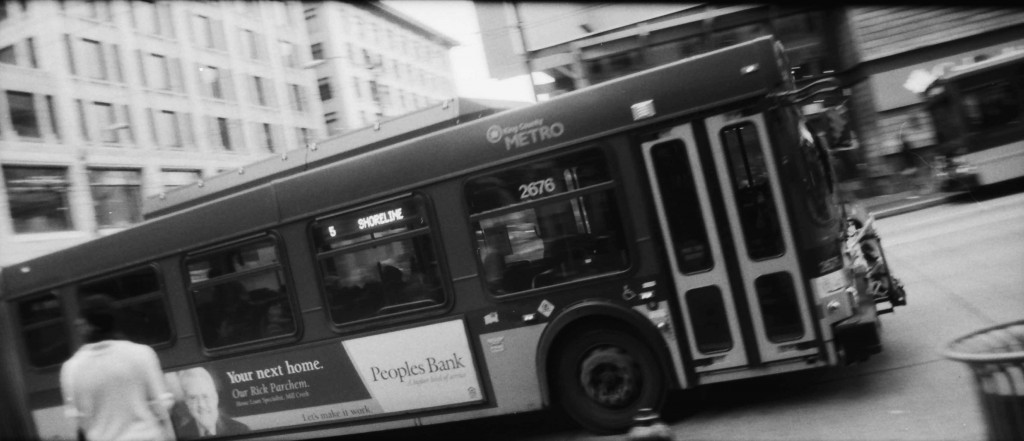
I help a young black American family with the wheelchair seat at Fifth and Jackson. He’s carrying laundry in tattered oversized Target plastic shopping bags. She’s got her baby in one arm and a stroller in the other. I get out of the seat and make room for them, lifting up a chair or two in the front area. They’re my buddies. I’m used to such textures on the 7, of life lived check to check, dirty clothes and smiles, relaxed standards for rules and language–it’s a vernacular one gets comfortable with, but from the outside I imagine it can seem pretty uninviting. As I walk back up a young Chinese man by the front doors asks if I go downtown.
“We are downtown,” I say. “Where downtown do you want to go?”
“Um. Uh.” He motions for a young woman of thirty and her father to come over, at which point he vanishes.
“Come on in, come on in,” I say to them in an impatient tone, thoughtlessly, hurrying them up. Why was I so concerned about making the light? What an unnecessary way to think!
“Hi,” I say to her. “Where do you want to go?”
She and her father are Chinese too, very clean-cut. They’re both crisply dressed, she in shades of cream, he in gray and blue, and they possess that distinctly Asian quality of demure, professional politeness. I’m reminded of my relatives. Not only are these two definitely not from around here, and lost on top of that, but they’re clearly very much out of their depth on this bus and its distinctive milieu.
In a labored accent she asks, “do you go to 6th Street?”
“I go to 6th Avenue…where on 6th Avenue do you want?”
“Um, the Sheraton?”
“Come on in,” I say in a friendlier voice, trying to mitigate my tone from earlier. “Do you know where on 6th Avenue that is?”
“It’s on 6th avenue….”
“Do you have an address? It’s a long street.”
“Yes. I’m sorry.”
“It’s okay.”
She’s stressed but quiet, looking it up on her phone. “It’s so hard to take a cab here.”
“Yes.” I feel bad for rushing them–for how it makes them feel, but also for how it makes me feel. Out of character.
“I’m sorry,” she says again as she waits for her phone.
“Maig wun tshee,” I reply. No problem.
“You speak Chinese!”
“Just a little!” Pause. “How is your day today?”
“It’s fine. We are just lost.”
We sort out where it is, and I tell them I’ll let them know when we get there. Meanwhile, the bus fills up while emptying out, that glorious sensation you get on through-routes, where as you traverse downtown, there’s a double load on the same bus: the crowd getting off from riding the 7, and the crowd getting on for the 49. A humming bustle of activity. I think about how they must be seeing all this, taking it in for the first time. This will live as part of their memory of Seattle. This crowd, and myself, represent Seattle for them right now. I should’ve been nicer when they got on, I’m thinking. We visited Seattle and were lost and uncomfortable, and the bus driver was in a hurry and didn’t seem to want to help…. How boring. How predictable. I make a point of making it a good ride through town. Throw all your energy into it, and don’t worry about having energy for later–that’ll come of its own accord, compounded on the good time you’re having now. Do it like there’s nothing between you and death except this ride. Shouldn’t I at least try to make this the best bus trip they’ll ever have in Seattle?
I put an extra pizzazz into the announcements, letting the enthusiasm grow and build, greeting everyone with focus, waving big at the other drivers, feeding off their energetic responses. Leave the stress behind. There’s more to you than that. We weave up Third Avenue, smooth, and I use the mic to keep people informed of the locations, the time, the turns, and underneath it all, my gratitude and enthusiasm at being here. Hyper-present.
At 4th & Pike I stand up, blocking the incoming masses, getting their attention again–“So this’ll be the one for you!”
“Oh, thank you,” she says. “Let’s go out the back,” she motions to her father.
“Oh, come on up it’s okay, I’ll show you which way to go.”
After explaining how to get to the Sheraton, I say, “welcome to Seattle!”
“Thank you!”
“Thank you! Tsai-chiyen!”
“Tsai-chiyen!”
Her demure smile expands richly, ebulliently, eyes lighting with recognition at hearing her native language. There she is. I miss the traffic light and am glad for it. A few more runners make the bus, and this is good. Let me flow with the people, not against them. I watch the pair cross the street, daughter and father. They’re looking up now, in a direction I can’t see, marveling at the city. No longer lost, they can pay attention to their surroundings in a different way. They tarry on their walk, taking everything in, feeling comfortable now that they know where they’re going. Acceptance. I tap the horn as I drive past. She looks over just in time to see my big wave.
Nathan Vass is an artist, filmmaker, photographer, and author by day, and a Metro bus driver by night, where his community-building work has been showcased on TED, NPR, The Seattle Times, KING 5 and landed him a spot on Seattle Magazine’s 2018 list of the 35 Most Influential People in Seattle. He has shown in over forty photography shows is also the director of nine films, six of which have shown at festivals, and one of which premiered at Henry Art Gallery. His book, The Lines That Make Us, is a Seattle bestseller and 2019 WA State Book Awards finalist.



